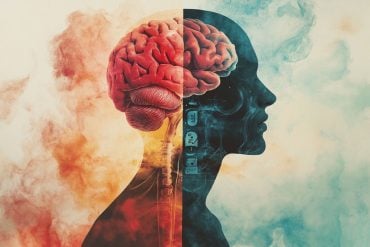Summary: Opioid use disorder affects genes associated with proinflammatory immune molecule encoding and genes associated with remodeling the extracellular matrix, suggesting the connection between neurons may be altered as a result of opioid use. Additionally, those with OUD have higher levels of microglia in the brain.
Source: Elsevier
The epidemic of opioid abuse affects millions of people worldwide, but researchers know surprisingly little about the molecular changes caused by opioids in the human brain.
A new study, which appears in Biological Psychiatry, aims to better understand those molecular events; showing that genes are expressed differently in the brains of people with opioid use disorder (OUD) compared to those not using opioids.
“These changes may explain not only the addictive properties of opioids but what ultimately causes harm to the brain and the person suffering with opioid use disorder,” said Ryan Logan, PhD, an Associate Professor at Boston University’s School of Medicine, Boston, MA, USA and senior author of the study.
“These gaps in our understanding of opioids’ actions in the brain limits our ability to develop more effective therapies,” Dr. Logan explained. “To address this, we employed new methods to identify novel molecular players directly in the brains of people who struggled with opioid use disorder.”
Dr. Logan and his team obtained autopsy brain tissue from 20 subjects with OUD and chronic opioid use, and 20 without a history of opioid use.
To identify differing patterns of gene expression, they used RNA sequencing (RNAseq), a technique that reflects how strongly genes are being expressed in a given tissue. RNAseq of the dorsolateral prefrontal cortex and the nucleus accumbens, two brain areas strongly associated with addiction pathophysiology, showed that certain genes were expressed differently in people with OUD compared to controls.
The affected genes fell into two broad categories: genes encoding proinflammatory immune molecules; and those involved in remodeling of the extracellular matrix, which suggests that connections between neurons may have been altered by opioid use.
The results also indicated that the brain’s resident immune cells, called microglia, were present at higher levels in the brains of people with OUD.

“We discovered several important molecular pathways that are integral in mediating the consequences of chronic opioid use on the brain. These molecules are responsible for shaping and maintaining the local environment required for neurons to function properly, as well as molecules critical for local inflammation that may impact the brain’s response to opioids. Together, these players represent new targets in both the pathology and treatment of opioid use disorder,” said Dr. Logan.
John Krystal, MD, Editor of Biological Psychiatry, said of the study: “The deeper we understand opioid use disorders, the more complex is the biology that emerges. This study highlights that opioid dependency is associated with expected changes in markers of neural response and plasticity, but also with neuro-inflammatory changes associated with microglia.
“These findings suggest important new directions that can be followed in larger studies and that broaden our view of the neurobiology, and potentially treatment, of opioid use disorder.”
About this addiction research news
Author: Rhiannon Bugno
Source: Elsevier
Contact: Rhiannon Bugno – Elsevier
Image: The image is in the public domain
Original Research: Open access.
“Transcriptional alterations in dorsolateral prefrontal cortex and nucleus accumbens implicate neuroinflammation and synaptic remodeling in opioid use disorder” by Marianne Seney, Sam-Moon Kim, Jill Glausier, Mariah Hildebrand, Xiangning Xue, Wei Zong, Jiebiao Wang, Micah Shelton, BaDoi Phan, Chaitanya Srinivasan, Andreas Pfenning, George Tseng, David Lewis, Zachary Freyberg, Ryan Logan. Biological Psychiatry
Abstract
Transcriptional alterations in dorsolateral prefrontal cortex and nucleus accumbens implicate neuroinflammation and synaptic remodeling in opioid use disorder
Background
Prevalence rates of opioid use disorder (OUD) have increased dramatically, accompanied by a surge of overdose deaths. While opioid dependence has been extensively studied in preclinical models, an understanding of the biological alterations that occur in the brains of people who chronically use opioids and who are diagnosed with OUD remains limited. To address this limitation, RNA sequencing was conducted on the dorsolateral prefrontal cortex and nucleus accumbens, regions heavily implicated in OUD, from postmortem brains in subjects with OUD.
Methods
We performed RNA sequencing on the dorsolateral prefrontal cortex and nucleus accumbens from unaffected comparison subjects (n = 20) and subjects diagnosed with OUD (n = 20). Our transcriptomic analyses identified differentially expressed transcripts and investigated the transcriptional coherence between brain regions using rank-rank hypergeometric orderlap. Weighted gene coexpression analyses identified OUD-specific modules and gene networks. Integrative analyses between differentially expressed transcripts and genome-wide association study datasets using linkage disequilibrium scores assessed the genetic liability of psychiatric-related phenotypes in OUD.
Results
Rank-rank hypergeometric overlap analyses revealed extensive overlap in transcripts between the dorsolateral prefrontal cortex and nucleus accumbens in OUD, related to synaptic remodeling and neuroinflammation. Identified transcripts were enriched for factors that control proinflammatory cytokine, chondroitin sulfate, and extracellular matrix signaling. Cell-type deconvolution implicated a role for microglia as a potential driver for opioid-induced neuroplasticity. Linkage disequilibrium score analysis suggested genetic liabilities for risky behavior, attention-deficit/hyperactivity disorder, and depression in subjects with OUD.
Conclusions
Overall, our findings suggest connections between the brain’s immune system and opioid dependence in the human brain.







